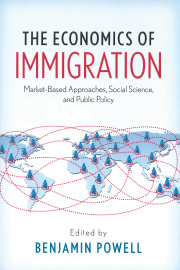Universities across the country are making an effort to ensure that products with their name on them are not made in sweatshops. U.S. unions, such as UNITE, the garment workers’ union, lobby to impose working standards for third world countries. Unfortunately these efforts actually hurt poor workers in third world countries more than help them.
A typical incident in the campaign against sweatshops occurred at a recent “Week of Sweat” campaign at Washburn University. Liana Foxvog, leader of SweatFree Communities, a national organization opposed to third-world sweatshops, congratulated the university because, she said, “there are student groups and university faculty interested that the clothing Washburn University buys isn’t made in sweat shops.” But abstaining from buying their products is a policy that harms workers.
Economists across the political spectrum, from Paul Krugman on the left to Walter Williams on the right, have defended sweatshops. The economic reasoning is straightforward. People choose what is in their perceived best interests. If workers voluntarily choose to work in a sweatshop, without being physically coerced, it must be because it is their best option compared to their other even worse alternatives.
Admittedly, sweatshops have abhorrently low wages and poor working conditions by western standards. However, economists point out that alternatives to working in a sweatshop are often much worse; oftentimes scavenging through trash, prostitution, crime, or even starvation are the other choices workers face.
Our recent research, “Sweatshops and Third World Living Standards: Are the Jobs Worth the Sweat?” forthcoming in the Journal of Labor Research, was the first economic study to systematically examine sweatshop wages compared to the living standards in the countries where they existed. We examined the apparel industry in countries often accused of having sweatshops and then we looked at 43 specific accusations of sweatshop wages in 11 countries throughout Asia and Latin America.
Our findings may seem surprising. Not only were sweatshops superior to the dire alternatives economists usually mentioned but they often provided a better than average standard of living in these countries for their workers.
The apparel industry, which is most often accused of unsafe working conditions and poor wages, actually pays relatively well compared to the poverty in the countries where they locate. While more than half of the population in most of the countries we studied lived on less than $2 per day, in 90 percent of the countries working a ten hour day in the apparel industry would lift a worker above, and often far above, that standard. For example, in Honduras, the site of the famous Kathy Lee Gifford sweatshop scandal, the average apparel worker earns, $13.10 per day, yet 44% of the country’s population lives on less than $2 per day.
In specific cases where companies have been accused of paying sweatshop wages we still find the jobs pay well compared to alternatives. In nine of the eleven countries, the reported sweatshop wages equal or exceed average incomes in the country where they are located, in some cases by a large margin. In Cambodia, Haiti, Nicaragua, and Honduras, the average wage paid in a firm accused of being a sweatshop is more than double the average income in that country’s economy.
Our findings should not be interpreted to mean that the jobs sweatshop workers have in the third world are ideal by U.S. standards. The point is, they are located in developing countries where these jobs are providing a higher wage than other work. Anti-sweatshop activists who argue to abstain from buying products made in sweatshops are harming workers by taking away some of the better jobs in their economy.
Buying products made in sweatshops would do more to help third world workers than college protests. Wages are determined by a worker’s productivity and next best alternative employment. By purchasing more products made in sweatshops we create more demand for them and increase the number of factories in these poor economies. That gives the workers more employers to choose from, raises productivity and wages and eventually improves working conditions. This is the same process of economic development the U.S. went through and it is ultimately how third world workers will raise their standard of living and quality of life.











